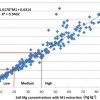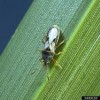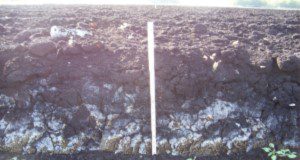This 4-page major revision, a publication of the UF/IFAS Department of Soil and Water Sciences, highlights the current status of Histosols within the Everglades Agricultural Area in southern Florida. Over the last century, soils within the region have gradually been lost via oxidation, a process commonly referred to as soil subsidence. The rate of subsidence is gradually declining, due to factors such as increased mineral content in soil, humification, and water management (maintenance of higher water tables). Best Management Practices and crop rotation help slow down the rate of oxidation and promote soil sustainability within the region. Written by Jehangir H. Bhadha, Alan L. Wright, and George H. Snyder.
https://edis.ifas.ufl.edu/ss523
Tag: Alan L. Wright
Extraction of Soil Nutrients Using Mehlich-3 Reagent for Acid-Mineral Soils of Florida
 Soil testing is a multistep process starting with the collection of a sample that adequately represents the area or field to be tested. Due to wide-ranging soil conditions across Florida and the United States, multiple soil test methods exist. During the 1970s, Florida along with several other southeastern US states adopted Mehlich-1 (M1) as the official extractant for acidic soils. The UF/IFAS Plant Nutrient Oversight Committee approved the change from M1 to M3 in 2010. Based on observations of the interpretations, the technical committee revised the M3 interpretation in March 2014. The new interpretations have been correlated with the M1 interpretations, as closely and realistically as possible, so the actual nutrient recommendations are not changed. This 7-page fact sheet was written by Rao Mylavarapu, Tom Obreza, Kelly Morgan, George Hochmuth, Vimala Nair, and Alan Wright, and published by the UF Department of Soil and Water Science, May 2014.
Soil testing is a multistep process starting with the collection of a sample that adequately represents the area or field to be tested. Due to wide-ranging soil conditions across Florida and the United States, multiple soil test methods exist. During the 1970s, Florida along with several other southeastern US states adopted Mehlich-1 (M1) as the official extractant for acidic soils. The UF/IFAS Plant Nutrient Oversight Committee approved the change from M1 to M3 in 2010. Based on observations of the interpretations, the technical committee revised the M3 interpretation in March 2014. The new interpretations have been correlated with the M1 interpretations, as closely and realistically as possible, so the actual nutrient recommendations are not changed. This 7-page fact sheet was written by Rao Mylavarapu, Tom Obreza, Kelly Morgan, George Hochmuth, Vimala Nair, and Alan Wright, and published by the UF Department of Soil and Water Science, May 2014.
http://edis.ifas.ufl.edu/ss620
Nitrogen Cycling and Management for Romaine and Crisphead Lettuce Grown on Organic Soils
 Lettuce has rapid growth and reaches harvest in 60–70 days in South Florida. This leads to high demands for nitrogen fertilization during the short growing season. A good N fertilization scheme should reduce costs, conserve natural resources, and minimize negative environmental impacts. The keys to using fertilizer efficiently are understanding the crop nutrient requirements to predict fertilizer needs and management as well as knowing the appropriate amounts to apply. Lettuce growers also need to know the nutritional status of the crop through soil and plant tissue testing. This 4-page fact sheet was written by Luis Santos, Alan L. Wright, Yigang Luo, Huangjun Lu, and D. Calvin Odero, and published by the UF Department of Soil and Water Science, September 2013.
Lettuce has rapid growth and reaches harvest in 60–70 days in South Florida. This leads to high demands for nitrogen fertilization during the short growing season. A good N fertilization scheme should reduce costs, conserve natural resources, and minimize negative environmental impacts. The keys to using fertilizer efficiently are understanding the crop nutrient requirements to predict fertilizer needs and management as well as knowing the appropriate amounts to apply. Lettuce growers also need to know the nutritional status of the crop through soil and plant tissue testing. This 4-page fact sheet was written by Luis Santos, Alan L. Wright, Yigang Luo, Huangjun Lu, and D. Calvin Odero, and published by the UF Department of Soil and Water Science, September 2013.
http://edis.ifas.ufl.edu/ss588
Nitrogen Cycling and Management for Romaine and Crisphead Lettuce Grown on Organic Soils
 Lettuce reaches harvest in 60–70 days in South Florida. This short growing season leads to high demands for nitrogen fertilization to maintain adequate plant-available N concentrations in the soil. Growers need to supply the required amounts of N to obtain high yields. Lettuce growers also need to know the nutritional status of the crop through soil and plant tissue testing. This 4-page fact sheet was written by Luis Santos, Alan L. Wright, Yigang Luo, Huangjun Lu, and D. Calvin Odero, and published by the UF Department of Soil and Water Science, September 2013.
Lettuce reaches harvest in 60–70 days in South Florida. This short growing season leads to high demands for nitrogen fertilization to maintain adequate plant-available N concentrations in the soil. Growers need to supply the required amounts of N to obtain high yields. Lettuce growers also need to know the nutritional status of the crop through soil and plant tissue testing. This 4-page fact sheet was written by Luis Santos, Alan L. Wright, Yigang Luo, Huangjun Lu, and D. Calvin Odero, and published by the UF Department of Soil and Water Science, September 2013.
http://edis.ifas.ufl.edu/ss588
Silicon Effects on Resistance of St. Augustinegrass to Southern Chinch Bugs and Plant Disease
 Silicon (Si) is the second most common element on earth, but it is not considered an essential element for plant growth. However, a growing body of evidence has shown that Si can enhance plant resistance to insect pests. This 5-page fact sheet reports the results of a study to determine if silicon applications to St. Augustinegrass varieties increase the silicon in the plants and how this increased silicon affects development and survival of southern chinch bugs as well as development of plant diseases. Written by Alan L. Wright, Ron Cherry, Huangjun Lu, and Pamela Roberts, and published by the UF Department of Soil and Water Science, September 2013.
Silicon (Si) is the second most common element on earth, but it is not considered an essential element for plant growth. However, a growing body of evidence has shown that Si can enhance plant resistance to insect pests. This 5-page fact sheet reports the results of a study to determine if silicon applications to St. Augustinegrass varieties increase the silicon in the plants and how this increased silicon affects development and survival of southern chinch bugs as well as development of plant diseases. Written by Alan L. Wright, Ron Cherry, Huangjun Lu, and Pamela Roberts, and published by the UF Department of Soil and Water Science, September 2013.
http://edis.ifas.ufl.edu/ss589
Phosphorus Fertilizer Recommendations for Sugarcane Production on Florida Organic Soils (SSAGR348/SC091)
 Much of the sugarcane grown in South Florida is on organic soils in the Everglades Agricultural Area, which is a phosphorus-limited system. Phosphorus loads in drainage water in the Everglades Agricultural Area are an environmental concern so it is important for sugarcane growers to use best management practices such as soil testing and to follow fertilizer recommendations. This document contains updated UF/IFAS phosphorus fertilizer recommendations for Florida organic soils. This 7-page fact sheet was written by J. Mabry McCray, Ronald W. Rice, and Alan L. Wright, and published by the UF Department of Agronomy, July 2012. http://edis.ifas.ufl.edu/sc091
Much of the sugarcane grown in South Florida is on organic soils in the Everglades Agricultural Area, which is a phosphorus-limited system. Phosphorus loads in drainage water in the Everglades Agricultural Area are an environmental concern so it is important for sugarcane growers to use best management practices such as soil testing and to follow fertilizer recommendations. This document contains updated UF/IFAS phosphorus fertilizer recommendations for Florida organic soils. This 7-page fact sheet was written by J. Mabry McCray, Ronald W. Rice, and Alan L. Wright, and published by the UF Department of Agronomy, July 2012. http://edis.ifas.ufl.edu/sc091
Lettuce Cultivars for Insect Resistance in Southern Florida (HS1196/HS1196)
 Florida’s subtropical climate facilitates lettuce production from fall through spring, but the warm, moist conditions are also favorable for insect proliferation and damage. Information about current cultivar response to common insect pests in Florida is limited, so UF/IFAS researchers conducted a study to evaluate cultivar response to insect infestation under field conditions and to identify resistance useful for integrated pest management. This 4-page fact sheet was written by Huangjun Lu, Alan L. Wright, and David Sui, and published by the UF Department of Horticultural Sciences, February 2012.
Florida’s subtropical climate facilitates lettuce production from fall through spring, but the warm, moist conditions are also favorable for insect proliferation and damage. Information about current cultivar response to common insect pests in Florida is limited, so UF/IFAS researchers conducted a study to evaluate cultivar response to insect infestation under field conditions and to identify resistance useful for integrated pest management. This 4-page fact sheet was written by Huangjun Lu, Alan L. Wright, and David Sui, and published by the UF Department of Horticultural Sciences, February 2012.
http://edis.ifas.ufl.edu/hs1196
Reclaimed Water Use for Edible Crop Production in Florida (SL360/SS561)
 Irrigating edible crops with reclaimed water is a promising, cost-effective solution to Florida's overuse of freshwater resources. Learn more in this 4-page fact sheet written by Jamie Lewis and Alan L. Wright and published by the UF Department of Soil and Water Science, September 2011.
Irrigating edible crops with reclaimed water is a promising, cost-effective solution to Florida's overuse of freshwater resources. Learn more in this 4-page fact sheet written by Jamie Lewis and Alan L. Wright and published by the UF Department of Soil and Water Science, September 2011.
http://edis.ifas.ufl.edu/ss561
A Guide to EPA’s Numeric Nutrient Water Quality Criteria for Florida (SL316/SS528)
This revised 10-page guide provides a basic, concise, and understandable description of the United States Environmental Protection Agency’s (EPA) numeric nutrient criteria for Florida, the background events that led to its release, some pertinent scientific issues, and implications for the future. Written by Thomas Obreza, Mark Clark, Brian Boman, Tatiana Borisova, Matt Cohen, Michael Dukes, Tom Frazer, Ed Hanlon, Karl Havens, Chris Martinez, Kati Migliaccio, Sanjay Shukla, and Alan Wright, and published by the UF Department of Soil and Water Science, March 2011.
http://edis.ifas.ufl.edu/ss528
SL323/SS535 Spring Mix: An Emerging Crop for Florida
SL323, a 3-page illustrated fact sheet by Santiago Rosaro, Alan L. Wright, David D. Sui, Nikol Havranek, and Yigang Luo, describes the components of spring mix, explains the reasons why consumers are looking for these mixes, and why growers in the Everglades Agricultural Area of Florida are producing them. Published by the UF Department of Soil and Water Science, June 2010.
http://edis.ifas.ufl.edu/ss535
SL311/SS523 Soil Subsidence in the Everglades Agricultural Area
SL311, a 3-page illustrated fact sheet by Alan L. Wright and George H. Snyder, describes the soils in the agricultural region in Florida south of Lake Okeechobee growing primarily sugarcane and winter vegetables, and addresses how the soils are changing with time. Includes references. Published by the UF Department of Soil and Water Science, November 2009.
http://edis.ifas.ufl.edu/ss523
SL316/SS528 A Guide to EPA’s Proposed Numeric Nutrient Water Quality Criteria for Florida
SL316, a 9-page illustrated guide by Thomas Obreza, Mark Clark, Brian Boman, Tatiana Borisova, Matt Cohen, Michael Dukes, Tom Frazer, Ed Hanlon, Karl Havens, Chris Martinez, Kati Migliaccio, Sanjay Shukla, and Alan Wright, provides a basic, concise, and understandable description of the United States Environmental Protection Agency’s (EPA) proposed numeric nutrient criteria for Florida, the background events that led to its release, some pertinent scientific issues, and implications for the future. Published by the UF Department of Soil and Water Science, February 2010.
http://edis.ifas.ufl.edu/ss528
SL310/SS522 The Role of Periphyton in the Everglades
SL310, a 3-page illustrated fact sheet by Pamela Brown and Alan L. Wright, defines periphyton, describes its role in nutrient cycling for the Everglades ecosystem, and explains the ongoing research related to periphyton in Everglades restoration. Includes references. Published by the UF Department of Soil and Water Sciences, November 2009.
http://edis.ifas.ufl.edu/ss522
SL294/SS507 Dissolved Organic Matter in Wetlands
SL-294, a 3-page illustrated fact sheet by Alan L. Wright and K. R. Reddy, describes the importance of dissolved organic matter and its role in regulating nutrients in terrestrial and aquatic ecosystems. Published by the UF Department of Soil and Water Science, June 2009.
http://edis.ifas.ufl.edu/SS507
SL302/SS515 Environmental Consequences of Water Withdrawals and Drainage of Wetlands
SL-302, a 3-page fact sheet by Alan L. Wright, educates the general public about how hydrologic conditions, such as drought and water withdrawal, influence the functioning and benefits of wetland ecosystems. Includes references. Published by the UF Department of Soil and Water Science, July 2009.
http://edis.ifas.ufl.edu/SS515
SL297/SS510 Reactivity and Mobility of Metals in Wetlands
SL-297, a 3-page fact sheet by Alan L. Wright and K.R. Reddy, discusses the role of metals in wetlands, their function, changes they undergo, and the potential hazards associated with their presence and accumulation in wetlands. Includes references. Published by the UF Department of Soil and Water Science, June 2009.
http://edis.ifas.ufl.edu/SS510
SL304/SS517 Wetland Eutrophication: Early Warning Biogeochemical Indicators
SL-304, a 3-page illustrated fact sheet by Alan L. Wright, describes the effects of nutrients in the Everglades and identifies sensitive early-warning indicators of ecological changes. Includes references. Published by the UF Department of Soil and Water Science, July 2009.
http://edis.ifas.ufl.edu/SS517
SL289/SS502 Wetland Delineation: An Overview of Regulations and Methods
SL289, a 4-page illustrated fact sheet by Daniel L. Irick, Yuncong Li, and Alan L. Wright, describe the regulatory nature of wetland delineation and classification for landowners, wetland and soil scientists, and the
general public. Includes references. Published by the UF Department of Soil and Water Science, May 2009.
http://edis.ifas.ufl.edu/SS502
SL301/SS514 Soil Structure in Everglades Agricultural Area Histosols: Effects on Carbon Sequestration and Subsidence
SL-301, a 6-page illustrated fact sheet by A.L. Wright and E. A. Hanlon, discusses organic soil oxidation relative to storing or releasing carbon and nitrogen, evaluates effects of cultivation, and uses this information to predict long-term outcomes for agricultural production and reclamation. Includes references. Published by the UF Department of Soil and Water Science, August 2009.
http://edis.ifas.ufl.edu/SS514
SL288/SS501 Greenhouse Gas Emissions in the Everglades: The Role of Hydrologic Conditions
SL288, a 5-page illustrated fact sheet by Alan L. Wright and K.R. Reddy, describes the relationship between global warming and increases in greenhouse gas emissions, the role of Everglades wetlands in the global carbon cycle and their contribution to greenhouse gas production, and how hydrologic conditions and eutrophication in the Everglades influence the rates and types of greenhouse gases emitted. Includes references. Published by the UF Department of Soil and Water Science, May 2009.
http://edis.ifas.ufl.edu/SS501
